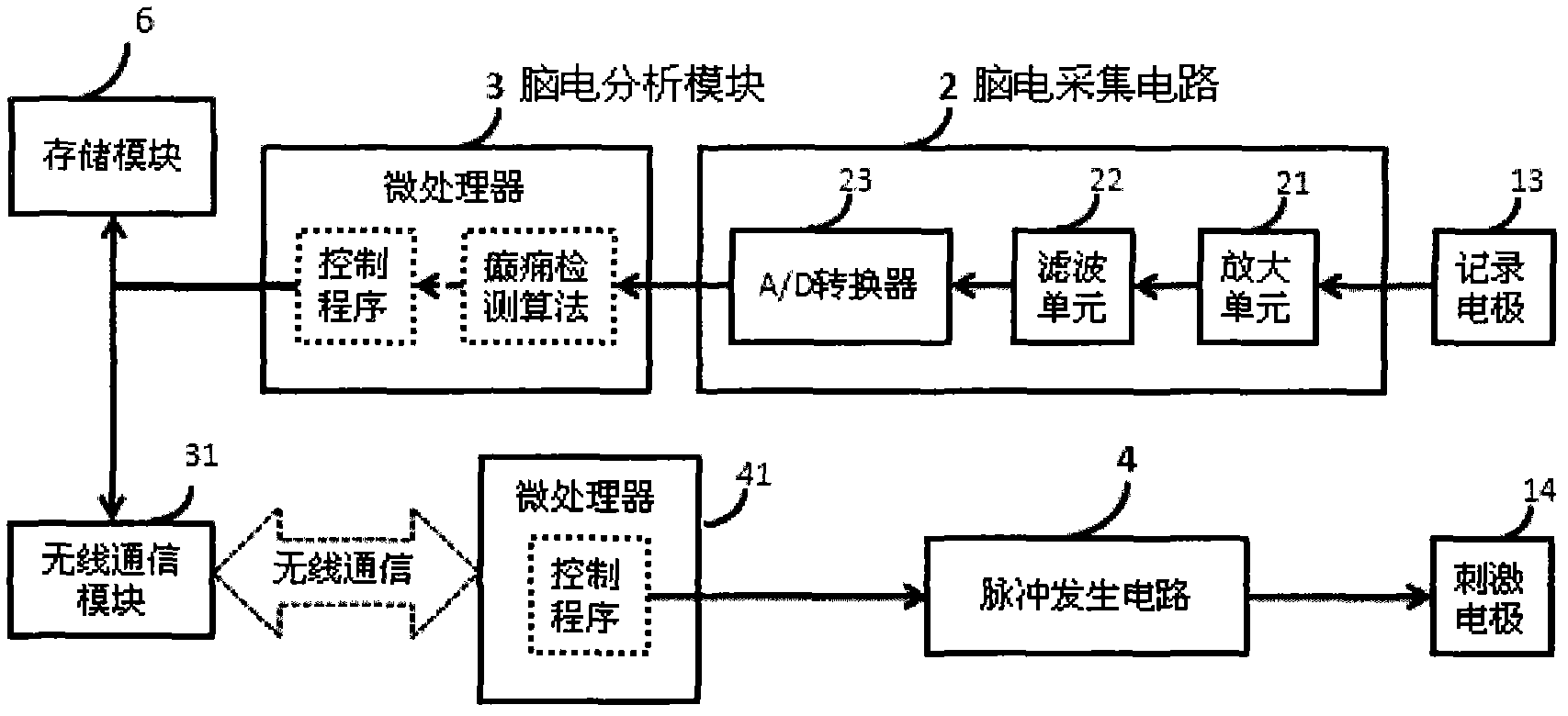Electroencephalograph (EEG)-based epilepsy detection and intervention device
An EEG, epilepsy technology, applied in the directions of diagnostic recording/measurement, medical science, artificial respiration, etc., can solve problems such as overstimulation, and achieve the effect of reducing stimulation, improving quality of life, and reducing the risk of side effects
- Summary
- Abstract
- Description
- Claims
- Application Information
AI Technical Summary
Problems solved by technology
Method used
Image
Examples
Embodiment approach 2
[0086] Reference attached figure 2 , an EEG-based epilepsy detection and intervention device includes two parts inside and outside the body. The external part includes: recording electrodes 13 , EEG acquisition circuit 2 , EEG analysis module 3 , wireless communication module 31 and storage module 6 . The internal body includes: a pulse generating circuit control unit 41 , a pulse generating circuit 4 , and stimulating electrodes 14 .
[0087] Different from the first implementation, the second implementation moves the EEG acquisition circuit and EEG analysis module that require strict low-power design to the outside of the body, so that these two parts are no longer limited by power consumption. also decrease. In this way, the external circuit does not need to select components with small size, low power consumption and high cost; the detection algorithm does not need to be optimized for a large number of calculation efficiency, and can run on a processor with faster calcu...
Embodiment approach 3
[0099] Refer to attached image 3 , an EEG-based epilepsy detection and intervention device includes: a recording electrode 13 , an EEG acquisition circuit 2 , an EEG analysis module 3 , an alarm module 5 and a storage module 6 . The device collects EEG through the recording electrode 13 arranged on the scalp and the EEG acquisition circuit 2 , and records it on the storage module 6 under the control of the EEG analysis module 3 . The EEG analysis module 3 runs the epilepsy detection algorithm to determine whether there is an epileptic seizure, and sends the result to the alarm module 5 for the patient's family members, doctors, and nurses to intervene in response to the patient, instead of using a machine to directly intervene in the patient.
[0100] Different from the first two implementations, the third implementation does not have fully implanted components, and the epilepsy detection algorithm does not directly intervene after detecting an epileptic seizure, but notifies...
PUM
 Login to View More
Login to View More Abstract
Description
Claims
Application Information
 Login to View More
Login to View More - R&D
- Intellectual Property
- Life Sciences
- Materials
- Tech Scout
- Unparalleled Data Quality
- Higher Quality Content
- 60% Fewer Hallucinations
Browse by: Latest US Patents, China's latest patents, Technical Efficacy Thesaurus, Application Domain, Technology Topic, Popular Technical Reports.
© 2025 PatSnap. All rights reserved.Legal|Privacy policy|Modern Slavery Act Transparency Statement|Sitemap|About US| Contact US: help@patsnap.com



